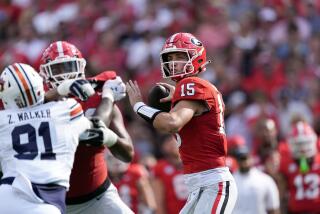Revenue Sharing Levels Field
Increased revenue sharing in the new baseball labor contract approved Friday wonât inspire the Oakland Athletics to keep pace with the power-shopping New York Yankees, and donât expect the Minnesota Twins to suddenly toss around $105-million contracts and private jets.
The wide gap separating the wealthiest clubs from the pack wonât be bridged during the four-year agreement despite more money being transferred to low-revenue teams, and a payroll tax designed to discourage spending might not be as effective as many small-market owners hope. But the revamped system could provide an economic boost for well-run franchises and give mistake-prone teams a wider margin for error, and at least thatâs a start.
âFrom our standpoint, the best thing that we could ever have is the ability to preserve what we have created,â Oakland General Manager Billy Beane said. âWeâre not necessarily looking for a chance to compete for the greatest free agents, we just want to keep the guys weâve developed.
âIf [the new agreement] helps us do that in any possible way, if it even helps us come close to being able to do that, weâd all be satisfied. How much it could [help] will be revealed in the next couple of weeks, but it could be significant.â
Under the new agreement, each team contributes 34% of its net local revenue, after deductions for ballpark expenses, to a pool that is redistributed equally to all 30 teams. The amount of money transferred from the high-revenue to low-revenue clubs will increase from $169 million to $258 million, based on 2001 revenue figures, when revenue sharing is fully implemented under a phased-in plan. The Dodgers generated $119.21 million in revenue last season and the Angels $67.33 million.
Payout figures cannot be determined until revenue is calculated after the season, but small-market clubs will receive a far greater percentage of their bigger competitorsâ profits. Owners demanded increased revenue sharing because they believe disparity in local revenue is responsible for the competitive gap between big-and small-market teams.
The Major League Baseball Players Assn., which contends that poor management is a bigger factor than owners concede, opposed revenue-sharing increases, in conjunction with a restrictive payroll tax, believing it was tantamount to a salary cap. But the union put aside its objections to complete a deal.
âIt wonât help as much as good player development, good administration and good management,â said Gene Orza, the unionâs associate general counsel. âIt will help some because youâre redistributing a sizable amount of money, but competitive balance is a tricky proposition.â
Not according to owners.
The basic concept of revenue sharing is that the entire sport benefits if high-revenue clubs share their profits to enable low-end teams to spend more money on players, increasing competitive balance. Only five clubs from the two lowest payroll groups participated in the playoffs from 1995-2001, and all lost in the first round.
And of the 224 postseason games played during that seven-year span, teams from the top two payroll groups went 219-5. The 1998 San Diego Padres were the only club from a lower payroll group to reach a World Series.
Owners were rebuffed in their attempts to implement a minimum $45-million payroll, which the union considered to be another restraint on salaries, and management in turn shot down the unionâs proposal to participate in monitoring how clubs spend their revenue-sharing money. The union sought to sanction clubs that it determined did not spend enough to improve.
Although the union would seemingly support all 30 clubs having a salary floor, it opposes any mandates on spending. The fear is that owners would eventually seek a hard cap in future negotiations if players open the door on this issue, saying the benefit of a payroll floor would be outweighed by a ceiling on the high-revenue teams that drive the market.
*
Times staff writer Ross Newhan contributed to this report.
More to Read
Go beyond the scoreboard
Get the latest on L.A.'s teams in the daily Sports Report newsletter.
You may occasionally receive promotional content from the Los Angeles Times.






